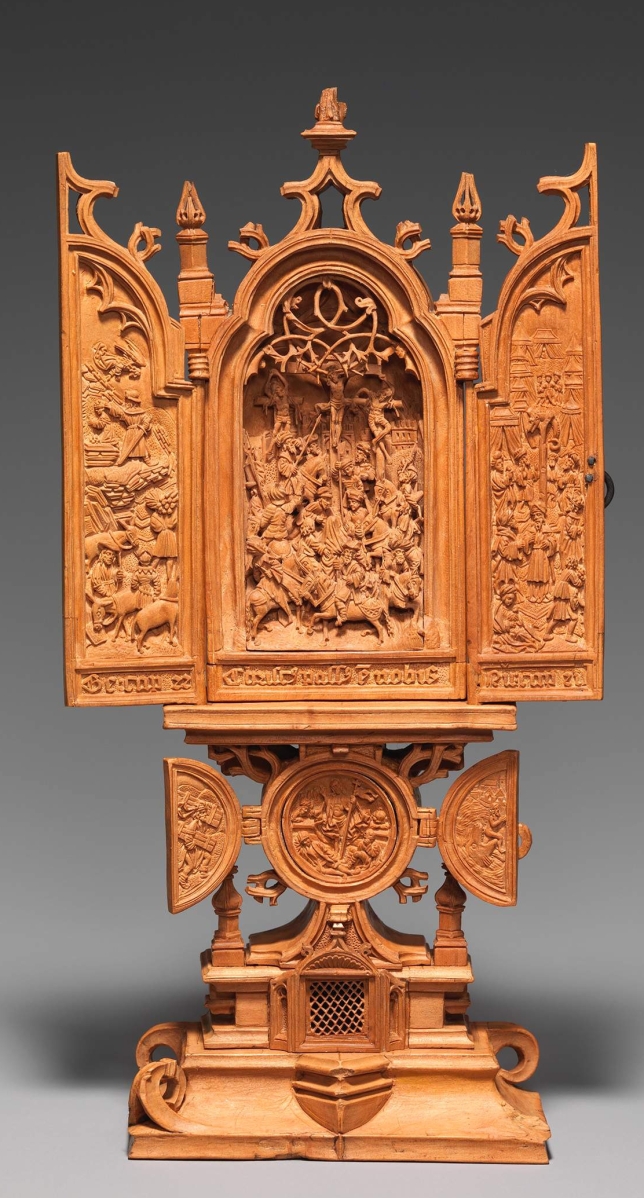.jpg)
Rosary, Netherlandish, 1500–39, boxwood, length: 20-7/8 inches. Musée du Louvre, Département des Objets d’art, Paris. ©Musée du Louvre. —Craig Boyko/Ian Lefebvre photo
NEW YORK CITY – Small in scale, yet teeming with life, miniature boxwood carvings have been a source of wonder since their creation in the Netherlands in the Sixteenth Century. On these intricately carved objects – some measuring a mere two inches in diameter – the miracles and drama of the Bible unfold on a tiny stage. The execution of these prayer beads and diminutive altarpieces seems almost as miraculous as the stories they tell and, in this first exhibition of its kind, the wizardry of the carvers who created these precious panoramas is revealed. Nearly 50 of these tiny treasures are featured in the exhibition “Small Wonders: Gothic Boxwood Miniatures at The Met Cloisters,” and will be on view February 22 through May 21 at the branch of The Metropolitan Museum of Art dedicated to medieval art and architecture – The Cloisters on the Upper West Side.
“Small Wonders” is organized by The Metropolitan Museum of Art, New York; the Art Gallery of Ontario, Toronto; and the Rijksmuseum, Amsterdam.

Miniature altarpiece with the Crucifixion, Netherlandish, early Sixteenth Century, boxwood, open: 5-7/8 by 3 by 1¼ inches. The Metropolitan Museum of Art, New York, gift of J. Pierpont Morgan, 1917. ©The Metropolitan Museum of Art. —Peter Zeray photo
Among the highlights is a complete carved boxwood rosary made for King Henry VIII of England and his first wife, Katherine of Aragon, before his notorious efforts to dissolve the marriage and his break from the Catholic Church. Equally remarkable is a diminutive sculpture, in the shape of the letter P, that opens to reveal scenes of the legend of Saint Philip. This newly discovered treasure has recently been acquired by The Met.
Used in prayer and meditation, such ingenious carvings enable access to a sacred realm. Among the images are: stories from the life of Jesus, saintly men and women and events from Hebrew scripture embraced by Christians as part of their own narrative – from the Biblical King David to the Queen of Sheba.
The artists’ techniques for creating these delicate works have defied comprehension for centuries, but now, through collaborative study by conservators at The Met and the Art Gallery of Ontario (AGO), their secrets have at last been unraveled. The conservators’ findings will be presented in the exhibition through video documentation and the display of a disassembled prayer bead.
Beloved in gardens across the world today, boxwood is a slow-growing evergreen, native to the Mediterranean region. In the Middle Ages, it was linked by biblical authority to the Holy Land. Dense and fine-grained, it is ideally suited to precision carving. Early illustrated botanical texts elucidating the medieval understanding of this valuable wood will also be on view in the exhibition. Plantings of boxwood in the gardens of The Met Cloisters will deepen appreciation for the artists’ extraordinary work in transforming the material from plant specimen to precious possessions.
The exhibition was organized by Alexandra Suda, curator of European art and the R. Fraser Elliott chair of the print and drawing council, Art Gallery of Ontario; Barbara Drake Boehm, the Paul and Jill Ruddock senior curator for The Met Cloisters; and Frits Scholten, senior curator of sculpture at the Rijksmuseum.
Ongoing scientific investigation into these objects – led by the AGO’s conservator of sculpture and decorative arts Lisa Ellis and The Met’s Pete Dandridge, conservator and administrator, department of objects conservation – has been assisted by scientists at the Canadian Conservation Institute; Sustainable Archaeology Centre, University of Western Ontario (London, Ontario); Museum of Natural History (London, England); National Technical Systems (Belcamp, Maryland); and NASA John H. Glenn Research Center (Cleveland, Ohio).
Before coming to The Met Cloisters, the exhibition was presented at the Art Gallery of Ontario, Toronto (November 5-January 22); and afterward it will be on view at the Rijksmuseum, Amsterdam (June 17-September 17). The exhibition is accompanied by a visitors’ guide published by the Art Gallery of Ontario, paperback, $19.95, and a catalog published by the Rijksmuseum, hardcover, $55. Both books are available in The Met Store at all museum locations. The Cloisters are at 99 Margaret Corbin Drive. For more information, 212-923-3700 or www.metmuseum.org/visit/met-cloisters.




.jpg)







